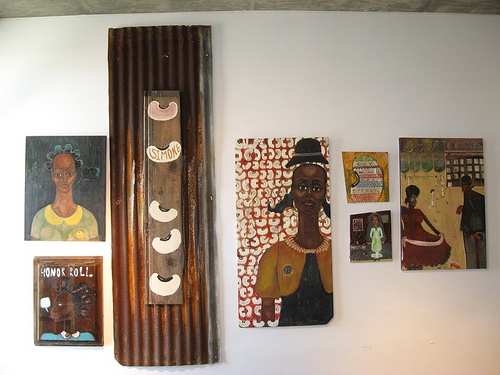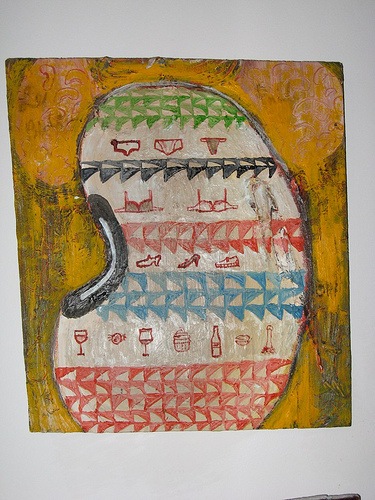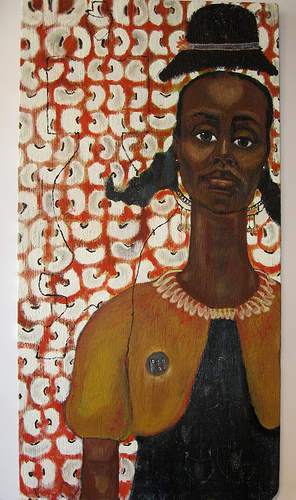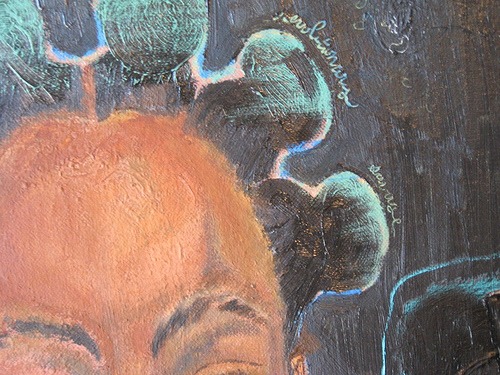Seeing with the Blackeyed Pea: The Art of Letitia Ntofon
My first encounter with Letitia Inyang Ntofon’s paintings was in The Black Dot Café located at 1195 Pine Street in deep West Oakland’s Black cultural district known as The Village Bottoms. I have known her for several years but mostly as a poet and writer. Her paintings, especially as they were arranged and installed on the wall in this location gave them an elusive narrative quality that grew the more that I looked at them. They felt like a story without a specific plot that contained many inscrutable details. Of the seven pieces at least two of them are self-portraits and that underlines the aura of autobiographical narrative in the paintings. They are made of found materials in irregular sizes that range from plywood to furniture fragments.
I was given another clue to the elusive narrative by the title that she gave for her seven painting installation. “Ekpu in the Fattening House.” I asked her what the title meant and she said that “…Ekpu are ancestor figures from Oron, Nigeria where my father is from. Fattening houses were traditionally where women learned the secrets of being a woman. When I started these paintings, I felt like an actress in a play in a way—I became possessed with the spirit of a young woman, a rebellious woman, entering the fattening house. She is questioning tradition, expectation, nobility. What you see here, might be something she hid away in a crevice in the house.” The artist/actor is trying to hold on to, secret away even, some small remnant of her own individuality as she goes through the ritual that makes her conform to the societal expectations for what a woman should be.
Ancestor veneration and ritual is a common concern of contemporary African Diasporic artists not only as personal reflection but the willful retrieval of African cultural ethos. Ntofon’s work draws on that ethos consciously and uses the form of some African writing systems to convey ideas about ancestor veneration and vision.
The small piece that is fifth in the sequence of paintings is titled “Initiation #1” and it directly draws from symbols used in West African secret societies. Ntofon clarified that the type of writing systems she is using, “…are symbols of the Ekpe society, also found in Oron, although it is not the only place where it exists.” Some examples of those writing systems are nsibidi writing originating from the leopard societies amongst the Ejagham people of Nigeria. I find that her work shares affinities with contemporary African artists such as Victor Ekpuk who also draws upon nsibidi writing and paints on found objects for a considerable part of his work. “Initiation #1” is one of three paintings that use the image of the black-eyed pea. Another is the self-portrait titled “Sumthin To Eat” that contains an engaging backdrop of black-eyed peas playing against just enough red between each pea to expose peeks at the plywood surface that it is painted on.
Ntofon says “…the pea for me also masquerades as the Oron“ordeal” bean, aka Calabar bean, a poisonous bean which was used to reveal alleged witches. The ordeal bean almost always killed those it accused, but if you were somehow able to still be breathing…you weren’t a witch. Some of its properties have been used in treating diseases of the eye, which is interesting to me…the whole connection to vision. Then, I think of how in a way the black eyed pea is our Black American ordeal bean…if these beans could talk they could probably tell the secrets of our whole history here.” The shape of the Black eyed pea could also signify the womb. Her reference to witches, and the allusion to the womblike pea as a revealer, speak to the hidden power of vision. In his classic work “Souls of Black Folks”, W.E.B. Dubois’ famously spoke of Black people being, “…gifted with a second sight in this American world…” The Black eyed pea in these paintings seem to serve as a metaphor for that particularly Black historical vision in America.
The third painting is a large vertical piece done on found wood mounted on a piece of corrugated metal of the type commonly seen in West Oakland as fences. Five large black-eyed peas dominate the piece. One pea contains the name “Simone” probably in remembrance of the great singer Nina Simone. The piece ties the artist’s use of her local environment to her concerns with Afri-diasporic symbolism. The corrugated metal is used in ghettos, favelas and shanty towns from the Jacarezinho favela in Rio De Janeiro to Lagos, Nigeria.
Although she is a self-taught artist, these types of aesthetic concerns prevent me from mistaking Ntofon’s work for the kind of self-taught art that Horace Pippin or Clementine Hunter may have produced in an earlier era. Her art consciously connects African ritual symbols (the Oron ordeal bean and nsibidi writing) to symbols common to the African experience in the Americas in the form of the black-eyed pea. Cornel West wrote of Horace Pippin’s art that it exemplified the crisis of the black visual artist in America. A crisis that West says was described in iconic terms by W.E.B. Dubois’ notion of “double consciousness.” “One ever feels his twoness – an American, a Negro; two souls, two thoughts, two unreconciled strivings; two warring ideals in one dark body, whose dogged strength alone keeps it from being torn asunder.” But Letitia Ntofon’s work has more than a concern for the false dichotomy of a “twoness.” She is concerned with a whole myriad of aesthetic strategies that transcend being labeled a western construct called a “negro” and another western construction called being an “American.” She is not seeing herself through the eyes of the western status quo. She is accessing the symbols and vision of African ritual. In doing so she also allows herself to reclaim stereotypic identity labels and use them as she sees fit.
The self-portrait entitled “After the Riot” exemplifies that tactic. “After the Riot” shows Ntofon as a wide-eyed seer with her hair worn in six knots atop her head. Each knot has a word written above it that is representative of various identities that Black folks navigate with or through. Above her head is written the words “nigger, negro, nationalist, militant, revolutionary and savage.” She explains, again drawing on the work of literary and stage artists, that her inspiration for the identities represented in this self-portrait come from,“…themes that the genius Barbara Ann Teer founder of the National Black Theater in Harlem, who died last year, worked with in her theatrical works. I was inspired by these, as phases of consciousness that we as Black people move through on a constant basis, intentionally and unintentionally. Teer made these as a rites of passage in a way. I added ‘Savage’ as another phase to move through, a self-acceptance of our cultural fierceness that can be used for either negative or productive purposes, and also a reclamation of how it has been used in the past against us.” The great poet/philosophers Leopold Senghor and Aime Cesaire used a similar tactic by reclaiming the French epithet negre and reincarnating it as Negritude or Blackness.
Letitia Ntofon’s work is one example of Black artists who make their art practice one that looks at African ontology such as that exemplified in the “fattening house” and applies those ways of being as their primary mode of self-reflection. This visual narrative is not genuflecting to the European canon to legitimize itself. Her work lends an open space for me to view her art and apply my own speculations about the story that was being told. I invite readers to come to west Oakland and view this work to see what your experience of this oblique story is.
Note: I would like to thank my wife Adeeba Dwanimen Deterville for assisting me by sharing her insight about the symbols relating to womanhood in Letitia Ntofon’s paintings.






Comments (10)
-
Nancy Nadel says:
November 15, 2010 at 3:01 pm
-
erin says:
April 26, 2010 at 12:59 pm
-
Frank Lostaunau says:
November 24, 2009 at 12:41 pm
-
Tiffany says:
November 23, 2009 at 12:00 pm
-
Lara says:
November 23, 2009 at 10:31 am
-
LiberianMidwife says:
November 23, 2009 at 9:53 am
-
Aishah says:
November 23, 2009 at 3:50 am
-
Amanda W says:
October 22, 2009 at 7:33 pm
-
Frank Lostaunau says:
October 21, 2009 at 1:33 pm
-
Lara says:
October 20, 2009 at 8:18 pm
See all responses (10)I am the proud owner of the painting “Sumthin to Eat.” It’s hangs in my West Oakland kitchen in my little house. I”d never bought a painting from a gallery before and I love it. I talk to it. It fills my home not only with a picture of Letitia which is a lovely addition but with the spirit behind her.
I heard The Lady with the Floating Hat, Sumthin To Eat, has been sold! Congratulations to you!
sorry that this has gotten ugly mes petites…i still like the lady with the floating hat!
I echo the sentiments of both Liberian Midwife and Lara. I fully support you, Letitia.
It’s funny that you would waste your time making negative, unnecessary comments. I would think that if you have any issues, you would be an adult and directly speak to Ms. Ntofon, instead of hiding yourself behind technology. You say all of these comments about someone, when you don’t realize that your words really reflect on the kind of person you are. So, really, whose the wannabee? Be upfront about your stuff because your actions have NOT represented any concern about the West Oakland community, it just shows a fear-driven person whose got nothing better to do.
This comment is for the Prescott Resident who inappropriately used this venue to lash out on a dear friend, phenomenal artist, loving mother, wife and community Pillar Letitia Ntofon. And your point for bringing all of this up is?… your comments about the artist and her relation to Marcel Diallo are to???This blog is about art and it’s social,political& spiritual impliclations for the artist and our community.Can we stay focused and give the sister her props for her journey and HER art…this is not about Marcel Diallo. I am sick of folks like you who hide behind the matrix aka the internet when you decide to get Political or stand up for a cause.Is this your idea raising public awareness? fostering community? Suppoting arts?Furthering the Panther’s mission? How effective…NOT. If you have issues with the Diallo family, find another method to address your concerns like face to face or with the person you have issues with? I believe that you think that you are really doing something by putting somebody on Blast but your not.
These works are beautiful! Thank you Letitia for feeding your creativity WHILE doing everything else you do. Breath of fresh air!!!
amazing. these are beautiful. very moving and inspirational work and a wonderful article about the work. thanks for sharing. im gonna go sit in the studio for awhile and marinate. thanks for the visual food!
What a treat to view Letitia Ntofon’s painting of the lady with the floating hat, “Sumthin to Eat”. sumthin to eat…indeed! VIVA LETITIA! VIVA!
Beautiful work! Love to see art that whether visually abstract or figurative, surprises with its its meaning for the artist. Her work reminds me a lot of folklore just in its visual representation and of the barber/hair shop painted signage found throughout Africa.